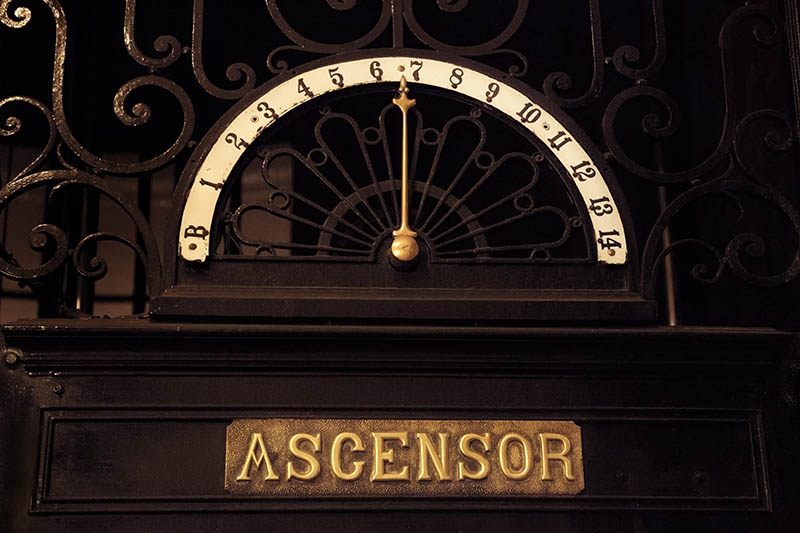The history of lifts
Contents |
[edit] Introduction
Lifts are vertical modes of transportation that move people or goods between storeys. The earliest known record of a lift can be traced back to Roman architect Vitruvius who reported Archimedes to have built the first one in 236 BC.
At the time, lifts were made from hemp rope and powered by animals or people; a vast difference to the modern lift. Over the years, lifts improved as construction and technology advanced, until they because what we see today.
[edit] Before Industrialisation
In a pre-industrial era, lifts were very different to its contemporary counterparts. In the year 1000, al-Muradi in his Book of Secrets told of a contraption similar to a lift that was used to raise a battering ram to destroy a fortress in Islamic Spain.
King Louis XV ordered the construction of a passenger lift, called ‘flying chair’, in the 18th century; more specifically, in 1743. The lift was installed outside the King’s balcony at the Chateau de Versailles and was operated by hand.
In 1793, the first screw drive lift was created by Ivan Kulibin and installed in the Winter Palace. This marked a significant step in lift history, as it was the precursor to the modern passenger lift.
[edit] The Industrial Revolution
Lifts that stemmed from steam-powered technology were only created in the 19th century after industrialisation made it possible to move large volumes of goods in mines and factories. In 1823, London architects Burton and Hormer constructed the ‘ascending room’, a tourist attraction powered by steam. It offered a unique panoramic view of London.
Sir William Armstrong created the hydraulic crane in 1846 for the purposes of loading cargo onto ships. It used a water pump and worked with water pressure to raise and lower the platform. Counterweights and balances were also applied.
[edit] From the 1850s to the 1900s
In 1852, in New York, Elisha Otis pioneered the safety lift, which ensured the cab wouldn’t fall if the cable snapped. The Equitable Life Building, in New York, was the first in the world to have passenger lifts in in 1870, and the first electric lift was invented in 1880 by Werner von Siemens in Germany. Alexander Miles, an inventor from the US, invented the automated doors.
The first hydraulic lift with push buttons (and without a driver) was operated on 1894, and the Paris Universal Exhibition had its first lift operated in 1900. By this year, automated lifts were available, although many people chose not to use them. A lift operator strike occurred in 1945, in New York, as well as the adoption of an emergency stop button, telephone and automated voice.
[edit] Modern lifts
Argentina saw the first vacuum lift offered commercially in 2000. The number of buildings over 200 m tripled since the year 2000, which also meant that more lifts were installed and new and improved technologies were developed. Lifts without ropes are already being developed.
[edit] Find out more
[edit] Related articles on Designing Buildings Wiki
- Considerations When Installing a Residential Lift.
- Lifts and Escalators: A Quality Perspective.
- Lifts and Their Special Operating Modes.
- Lifts for buildings.
- Lifts for office buildings.
- The science of lifts.
- The world's fastest lifts.
- Top factors to consider when planning to install a lift.
- Winchester House.
--Nathan Massey 14:25, 11 Jul 2017 (BST)
Featured articles and news
Deputy editor of AT, Tim Fraser, discusses the newly formed society with its current chair, Chris Halligan MCIAT.
Barratt Lo-E passivhaus standard homes planned enmasse
With an initial 728 Lo-E homes across two sites and many more planned for the future.
Government urged to uphold Warm Homes commitment
ECA and industry bodies write to Government concerning its 13.2 billion Warm Homes manifesto commitment.
Places of Worship in Britain and Ireland, 1929-1990. Book review.
The emancipation of women in art.
CIOB Construction Manager of the Year 2025
Just one of the winners at the CIOB Awards 2025.
Call for independent National Grenfell oversight mechanism
MHCLG share findings of Building Safety Inquiry in letter to Secretary of State and Minister for Building Safety.
The Architectural Technology Awards
AT Awards now open for this the sixth decade of CIAT.
50th Golden anniversary ECA Edmundson awards
Deadline for submissions Friday 30 May 2025.
The benefits of precast, off-site foundation systems
Top ten benefits of this notable innovation.
Encouraging individuals to take action saving water at home, work, and in their communities.
Takes a community to support mental health and wellbeing
The why of becoming a Mental Health Instructor explained.
Mental health awareness week 13-18 May
The theme is communities, they can provide a sense of belonging, safety, support in hard times, and a sense purpose.
Mental health support on the rise but workers still struggling
CIOB Understanding Mental Health in the Built Environment 2025 shows.
Design and construction material libraries
Material, sample, product or detail libraries a key component of any architectural design practice.
Construction Products Reform Green Paper and Consultation
Still time to respond as consultation closes on 21 May 2025.
Resilient façade systems for smog reduction in Shanghai
A technical approach using computer simulation and analysis of solar radiation, wind patterns, and ventilation.


























Comments